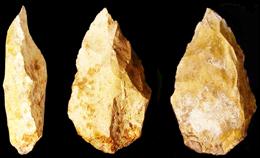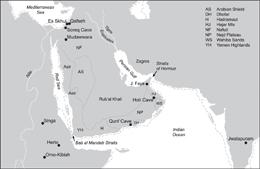Early human migration written in stone tools
Humans may have trekked across the Arabian peninsula 125,000 years ago, on their way to Asia.
 Hand axes like this one found in the United Arab Emirates indicate humans left Africa 125,000 years ago.Science/AAAS
Hand axes like this one found in the United Arab Emirates indicate humans left Africa 125,000 years ago.Science/AAASThe stone tools, some up to 125,000 years old, resemble those made by modern humans in Africa around the same period. Their makers crossed the Red Sea, trekked across Arabia during favourable climate conditions, and perhaps went on to settle in Asia, suggests an international team of scientists.
"They are our ancestors. I have no doubt about that," said team leader Hans-Peter Uerpmann of the University of Tübingen, Germany, in a telephone press conference. His team published its findings online today in Science1.
Other archaeologists say that the stone tools could have been produced by other archaic human relatives. And they point to genetic evidence from contemporary humans indicating that the ancestors of today's non-Africans left sometime around 65,000 years ago, quickly fanning out across Europe, Asia and even reaching Australia.
That sequence of events doesn't leave much time for exploration, says team member Anthony Marks, an archaeologist at Southern Methodist University in Dallas, Texas. "The idea that they left Africa at 60,000 and ended up at Australia at 50,000 — my God, did they ever stop running!" he asks.
Genetic evidence is unclear about the path that modern humans took out of Africa. But caves in Israel dated to between 80,000 and 120,000 years ago, containing ostensibly human artefacts and remains, suggest a northern route, along the Nile, or from the Sahara. These early explorers probably never made it beyond the Levant, but many archaeologists have suggested that a later wave of humans followed a similar route.
Distinct impressions
The stone tools found buried under a collapsed rock overhang, at a site called Jebel Faya in the present-day United Arab Emirates, suggest a different route, says Uerpmann's team. Nearly 2,000 kilometres of inhospitable desert lie between the Red Sea and Jebel Faya. But by around 130,000 years ago the world was at the end of an ice age. The Red Sea may have been shallow enough to be crossed on foot or on a raft, and the Arabian peninsula was being transformed from a parched desert into a savannah, not unlike East Africa. The
location of Jebel Faya, United Arab Emirates. The dashed line indicates
the maximum exposure of land during marine lowstands. Click for larger
image.Science/AAAS
The
location of Jebel Faya, United Arab Emirates. The dashed line indicates
the maximum exposure of land during marine lowstands. Click for larger
image.Science/AAASThe oldest assemblage — consisting of about 500 pieces from 31 tools — bears a signature of its makers, says Marks. For instance, the methods used to make many of the stone tools involved reducing a larger piece of stone into a two-sided blade, a technique thought to have been commonly used in the manufacture of tools in East Africa at the time, says Marks. The tools themselves — hand-held axes and leaf-like blades that might have been attached to spears — also resemble those made in East Africa by early modern humans and not by archaic relatives known to have lived nearby, he adds.
The two younger collections, on the other hand, resemble little else in the archaeological record, Marks says. "They look like basic Walmart tools. There's nothing distinctive about them, except the absence of distinctive elements."
Marks and his colleagues say that the lack of distinction suggests that this early human population arrived from Africa around 125,000 years ago and then became isolated when the Arabian peninsula turned to desert again. This group, they suggest, could have used Jebel Faya as a launch pad to the rest of Asia. Between about 75,000 and 14,000 years ago, the coast of Iran would have been easily reached from near Jebel Faya, across the Gulf.
Controversy
"I think it's provocative," says Richard Klein, a palaeoanthropologist at Stanford University in California. The tools could point to an early out-of-Africa migration. Alternatively, he says, they could indicate that the Arabian peninsula was, ecologically, an extension of Africa at times.
ADVERTISEMENT
According to Chris Stringer, a paleoanthropologist at the Natural
History Museum in London, the paper adds ammunition to the
"controversial" theory that humans populated southern Asia long before
genetic evidence in contemporary humans would indicate. But John Shea, an archaeologist at Stony Brook University in New York, isn't yet convinced that modern humans from Africa made the tools, and says a number of archaic human groups present in Eurasia at the time were capable of producing them.
However, an answer should come from further excavation, he says. "If the Jebel Faya evidence is the product of an early human dispersal into Asia, then further evidence of that dispersal should be found on the Iranian coast and its hinterland."
Nenhum comentário:
Postar um comentário
Observação: somente um membro deste blog pode postar um comentário.